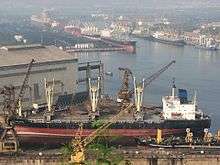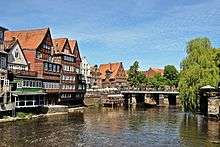Harbor
A harbor or harbour (see spelling differences), or haven, is a body of water where ships, boats and barges seek shelter from stormy weather, or are stored for future use. Harbors and ports are often confused with each other. A port is a manmade facility built for loading and unloading vessels and dropping off and picking up passengers. Ports are often located in harbors.
Harbors can be natural or artificial. An artificial harbor can have deliberately constructed breakwaters, sea walls, or jettys, or they can be constructed by dredging, which requires maintenance by further periodic dredging. An example of an artificial harbor is Long Beach Harbor, California, United States which was an array of salt marshes and tidal flats too shallow for modern merchant ships before it was first dredged in the early 20th century.[1]
In contrast, a natural harbor is surrounded on several sides by prominences of land. Examples of natural harbors include Sydney Harbour, Australia and Trincomalee Harbour in Sri Lanka.
Artificial harbors
Artificial harbors are frequently built for use as ports. The oldest artificial harbor known is the Ancient Egyptian site at Wadi al-Jarf, on the Red Sea coast, which is at least 4500 years old (ca. 2600-2550 BC, reign of King Khufu). The largest artificially created harbor is Jebel Ali in Dubai.[2] Other large and busy artificial harbors include:
- Port of Rotterdam, Netherlands;
- Port of Houston, Texas, United States;
- Port of Savannah, Georgia, United States;
- Port of Long Beach, California, United States;
- Port of Los Angeles in San Pedro, California, United States.
The Ancient Carthaginians constructed fortified, artificial harbors called cothons.
Natural harbors

A natural harbor is a landform where a part of a body of water is protected and deep enough to furnish anchorage. Many such harbors are rias. Natural harbors have long been of great strategic naval and economic importance, and many great cities of the world are located on them. Having a protected harbor reduces or eliminates the need for breakwaters as it will result in calmer waves inside the harbor. Some examples are:
- New York Harbor in the United States;
- Poole Harbour in England, United Kingdom;
- Kingston Harbour in Jamaica;
- Grand Harbour in Malta;
- Marsamxett Harbour in Malta;
- Subic Bay in Zambales, the Philippines;
- Scapa Flow in Scotland, United Kingdom;
- Sydney Harbour in Australia; technically a ria
- Pearl Harbor in Hawaii, United States;
- Trincomalee Harbour in Sri Lanka;
- San Francisco Bay in California, United States;
- Visakhapatnam Harbour in India;
- Killybegs in County Donegal, Ireland;
- Halifax Harbour in Nova Scotia, Canada;
- Hamilton Harbour in Ontario, Canada;
- Burrard Inlet in Vancouver, Canada;
- Cork Harbour, Ireland;
- Waitemata Harbour in Auckland, New Zealand.
- Port of Tobruk in Tobruk, Libya.
Ice-free harbors
For harbors near the North and South Poles, being ice-free is an important advantage, especially when it is year-round. Examples of these include:
- Murmansk, Russia;
- Pechenga, Russia;
- Liinakhamari, Russia;
- Hammerfest, Norway;
- Vardø, Norway;
- Vostochny Port;
- Nakhodka in Nakhodka Bay, Russia;
- Prince Rupert Harbour, Canada.
The world's southmost harbor, located at Antarctica's Winter Quarters Bay (77° 50′ South), is potentially ice-free, depending on the summertime pack ice conditions.[3]
Important harbors


Although the world's busiest port is a hotly contested title, in 2006 the world's busiest harbor by cargo tonnage was the Port of Shanghai.[7]
The following are large natural harbors:
- Algeciras, Spain
- Amsterdam, Port of Amsterdam, Netherlands
- Antwerp, Port of Antwerp, Flanders, Belgium
- Baltimore's Inner Harbor, Maryland, United States
- Boston Harbor, Massachusetts, United States
- Bremerhaven, Germany
- Buenos Aires, Argentina
- Burrard Inlet, Vancouver, British Columbia, Canada
- Busan, Korea
- Cartagena, Colombia
- Charleston, South Carolina, United States
- Chennai, Tamil Nadu, India
- Port of Chittagong, Chittagong City, Bangladesh
- Cork Harbour, Ireland
- Duluth–Superior harbor, Duluth, Minnesota, United States
- Durban, South Africa
- Falmouth, Cornwall, England, United Kingdom
- Freetown Harbour, Sierra Leone
- Golden Horn, Istanbul, Turkey
- Gothenburg, Sweden
- Grand Harbour, Malta
- Gwangyang, Korea
- Hai Phong Port, Haiphong, Vietnam
- Halifax Harbour, Nova Scotia, Canada
- Hamburg Harbour, Germany
- Hampton Roads, Norfolk, Virginia, United States
- Havana Harbor
- Incheon, Korea
- Izmir, Turkey
- Port of Jakarta (Tanjung Priok), Jakarta, Indonesia
- Karachi, Sindh, Pakistan
- Kingston, Jamaica
- Kobe Harbour, Kobe, Japan
- Lisbon, Portugal
- Lushunkou, Dalian, China
- Mahón, Minorca, Spain
- Manila Bay, Philippines
- Maputo, Mozambique
- Milford Haven, Wales, United Kingdom
- Montevideo, Uruguay
- Mumbai, India
- Nassau, Bahamas
- New York Harbor, United States
- Oslofjord, Norway
- Pearl Harbor, Honolulu, Hawaii, United States
- Piraeus, Attiki, Greece
- Plymouth Sound, Devon, England, United Kingdom
- Poole Harbour, Dorset, England, United Kingdom
- Port Jackson, Sydney, New South Wales, Australia
- Port of Portland, Casco Bay, Maine, United States
- Port of Sevastopol, Sevastopol, Ukraine
- Port Phillip, Melbourne, Victoria, Australia
- Provincetown Harbor, Provincetown, Massachusetts, United States
- Punta del Este, Uruguay
- Rio de Janeiro, Guanabara Bay, Brazil
- Rotterdam, Port of Rotterdam, Netherlands
- Salvador, All Saint's Bay, Brazil
- San Antonio, Chile
- San Diego Bay, San Diego, California, United States
- San Francisco Bay, California, United States
- Sankt Petersburg, Russia
- Subic Bay, Zambales, Philippines
- Tanger-Med, Tangier, Morocco
- Tauranga Harbour, Tauranga, New Zealand
- Tokyo Bay, Tokyo, Japan
- Trincomalee, Sri Lanka
- Tuticorin, Tamil Nadu, India
- Port of Tyne, Tyne & Wear, United Kingdom
- Ulsan, Korea
- Victoria Harbour, Hong Kong
- Victoria Harbour (British Columbia) & Esquimalt Harbour, Victoria, British Columbia, Canada
- Visakhapatnam Port, Andhra Pradesh, India
- Vizhinjam, Trivandrum, India
- Waitemata Harbour, Auckland, New Zealand
- Willemstad, Curaçao
- Wellington Harbour, New Zealand
Other notable harbors include:
- Belém, Brazil
- Port of Bruges-Zeebrugge, Flanders, Belgium
- Port of Genoa, Italy
- Port of Gdańsk, Poland
- Kahului, Hawaii, United States
- Kaipara Harbour, New Zealand
- Kaohsiung, Taiwan
- Keelung, Taiwan
- Keppel Harbour, Singapore
- Kilindini Harbour, Kenya
- Manukau Harbour, Auckland, New Zealand
- New Haven Harbor, Connecticut, United States
- Portland Harbour, Dorset, England, United Kingdom
- Rades, Tunisia
- Rio Grande, Brazil
- San Juan, Puerto Rico, United States
- Scapa Flow, Orkney Islands, Scotland, United Kingdom
- Sydney Harbour, Australia
- Port of Szczecin, Poland
- Trondheim, Norway
- Valparaiso, Chile
- Vladivostok, Russia
See also
Notes
- ↑ http://geology.campus.ad.csulb.edu/people/bperry/geology303/geol303chapter8.html
- ↑ Hattendorf, John B. (2007), The Oxford encyclopedia of maritime history, Oxford University Press, p. 590, ISBN 978-0-19-513075-1
- ↑ U.S. Polar Programs National Science Foundation FY2000.
- ↑ "Circuit Guide | Punta del Este, Uruguay". FIA Formula E. Retrieved 2014-08-24.
- ↑ "Formula E reveals circuit for Punta del Este ePrix". FIA Formula E. 2014-06-20. Retrieved 2014-08-24.
- ↑ "Formula E unveils Punta del Este circuit in Uruguay". autosport.com. 2014-06-20. Retrieved 2014-08-24.
- ↑ AAPA World Port Rankings 2006
External links
| Wikimedia Commons has media related to Harbors. |
| Look up harbor in Wiktionary, the free dictionary. |





